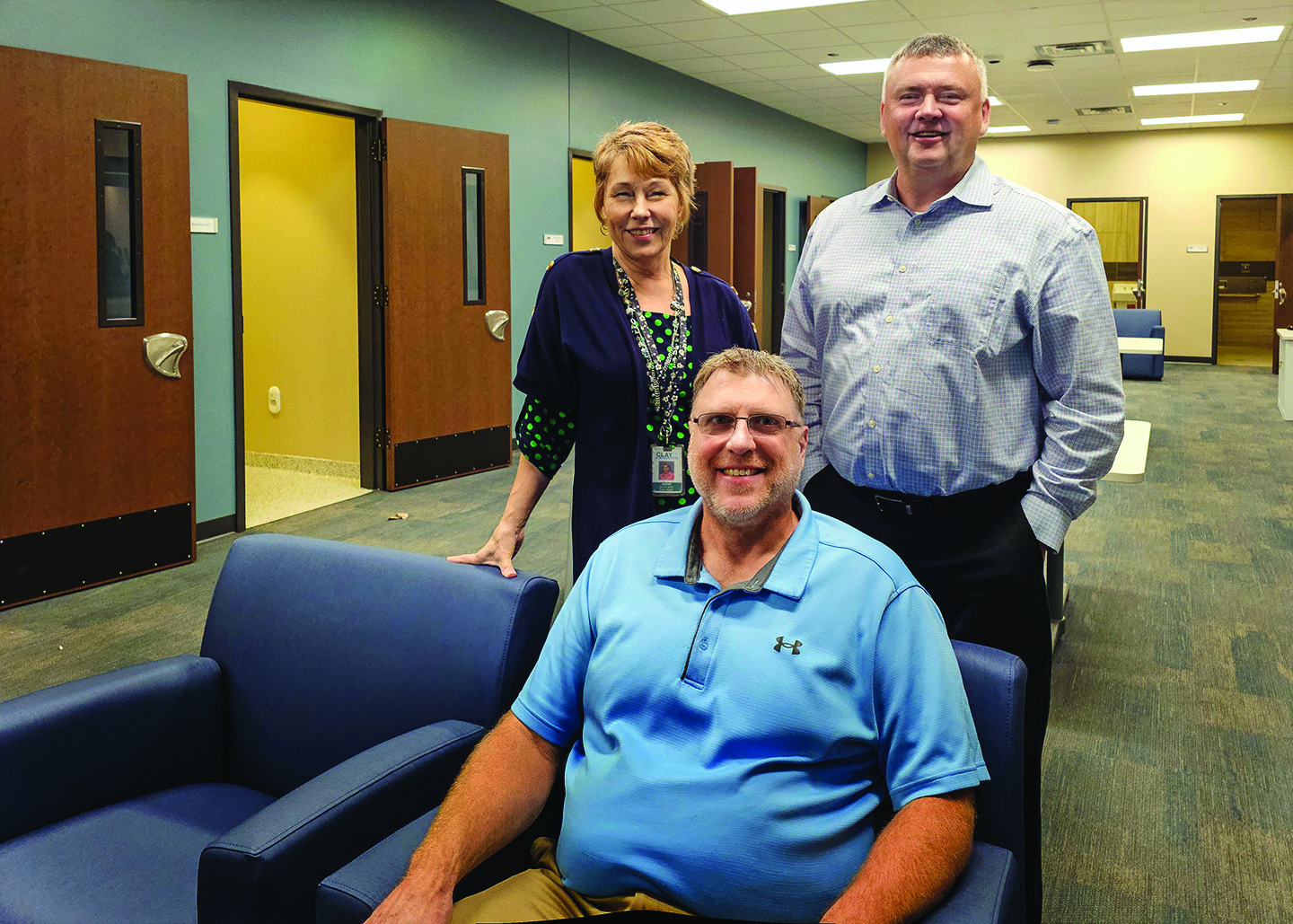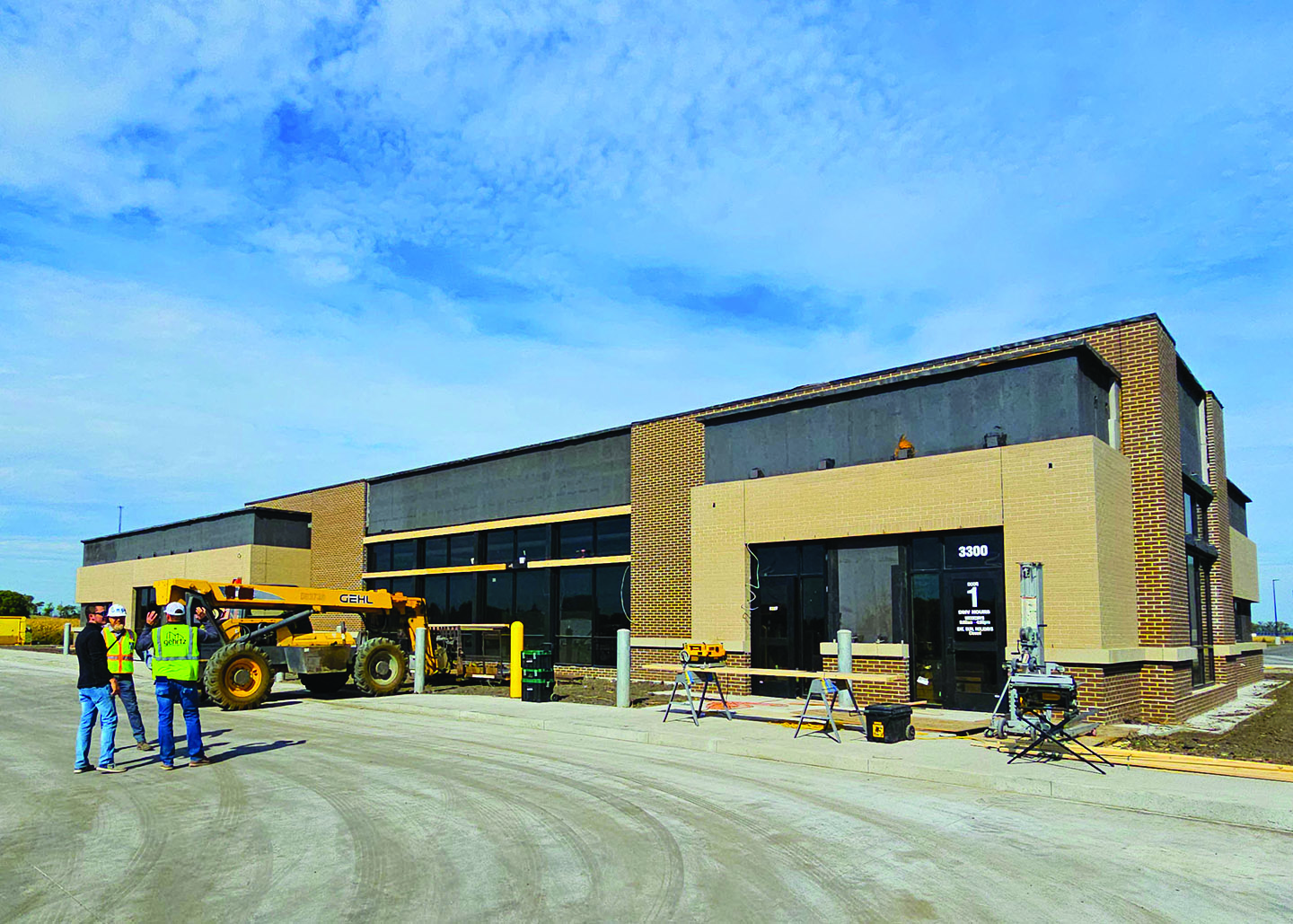
Clay County Detox Unit director Troy Amundsen (seated), Public Health administrator Kathy McKay and county administrator Stephen Larson show off a day room in the new Withdrawal Management/Detox Center. (Photos/Nancy Hanson.)

Clay County’s new Withdrawal Management/Detox Center on 15th Avenue North is expected to be ready to go in late October.

The new Clay County Department of Motor Vehicles will open its new facility on 15th Avenue North on Oct. 18. Looking over the new facility (at left) are construction manager James Lansing, Ryan Weber of Klein-McCarthy Architects and Carson Sonstegard of Gehrtz Construction
Nancy Edmonds Hanson
Clay County is opening the doors of two new facilities on Tuesday – the permanent home of the Department of Motor Vehicles and the all-new Withdrawal Management/Detox Center – a little early.
It’s not quite their functional openings. The DMV will begin doing business in its new quarters on Monday, Oct. 21, while the Detox Center expects to be ready for a full opening by the end of October. But in honor of the near-readiness of the two buildings, the departments are hosting a joint open house at 1 p.m. Tuesday afternoon (Oct. 1).
The public will be able to get a peek at the new DMV, where they’ll soon be renewing their driver’s licenses and buying vehicle tabs three weeks from now.
They can also tour the center where professionals will soon be aiding citizens who are shaking off the effects of alcohol and drug use – a facility four times as large as the tightly cramped Detox Unit that has served them in the Family Service Center for more than 30 years.
The need for both projects has spurred heavy construction activity southwest of the Resource Recovery Center just to the north of the two projects.
The DMV has been located in leased space in the old Center Mall since November 2020, when it left its small former building to the west of the new site for larger, more COVID-avoidant quarters. With much of the downtown mall already leveled and the rest of it soon to go, the Clay County Commission accelerated construction of its replacement. The mall-based office will serve its last clients on Friday, Oct. 18, and – thanks to a specialized moving crew – reopen the following Monday on 15th Avenue.
While the demolition of the Center Mall clearly added urgency to the DMV move, the new Detox Center will also meet a compelling need. The present unit in the old St. Ansgar Hospital provides only 16 beds in dormitory-like rooms for men and women suffering from acute alcohol and drug intoxication. It sometimes has to turn away those in crisis for lack of room, and is chronically short of both privacy and areas where residents can meet with professionals.
The new center – designed to be a regional hub for surrounding Minnesota and North Dakota counties – will accommodate twice the number of clients, all 32 of them in small private rooms grouped around spacious day rooms where they will meet and eat. Two large nurses’ stations have a clear view of activities in day rooms that encircle them. Other areas are provided for intake, medical checks and consultations related to the residents’ recovery.
The layout, notes director Troy Amundsen, is flexible – a solution to the problem of balancing accommodations for fluctuating numbers of male and female clients, always an issue in the multi-person rooms in the old unit. Some of those women going through withdrawal are also pregnant; Amundsen estimates they see a dozen of so cases every year. Public health administrator Kathy McKay points out that the new Clay County facility will be one of the few prepared to care for their special needs.
Round-the-clock nursing and 24-hour access to a medical director provide quick response to emergencies, whether they can be handled by the staff on duty or require transport to a hospital emergency room. The center’s staff – about 50 when all new positions have been filled – includes registered nurses, LPNs, medical technologists, licensed alcohol and drug counselors and peer support specialists.
The detox center, Amundsen says, serves adults from all walks of life. Some — about 40%, he estimates — are brought there for help by law enforcement officers. Another 25% admit themselves, fearing the seizures and other complications brought on by extreme intoxication. Ambulances may transfer some from hospital emergency rooms. Most of the rest come through the court system through Minnesota’s 72-hour commitment hold. “They need to be in a facility until they can get into treatment programs,” he notes. Given the shortage of beds in such programs, their stays may stretch into months.
The anticipated opening of the Withdrawal Management/Detox Center has been delayed a few weeks, McKay says, by the longer-than-expected wait for some small but critical security features like door locks. She expects the move to take place by the end of October.
Over at the DMV, finishing touches are being placed on the area where clients seeking licenses will wait and the windows where staff will serve them. The new building has given an opportunity to rethink how to move the public more quickly through the process. One innovation: a second camera for taking those notorious driver’s license photos.
Part of the DMV building will remain empty for the time being. Larson explains that Minnesota opted to continue administering drivers tests in the old building at the time the county moved downtown to the mall; they’re now given from a building on Highway 10. When that lease expires, however, the state plans to move testing back to the side of the county’s license operation.
Clay County is still negotiating for city bus service to the new DMV site. The administrator points out that a sizable portion of those who will come there to apply will not already have valid driver’s licenses, and thus have no other legal way to reach the office other than walking. The location is more than a mile from the nearest bus stop on 34th Street.
Larson notes that some residents have questioned why the county operations were moved to the north edge of Moorhead, given the availability of several empty buildings around town. None of those met the programs’ specific needs, he says.
The first: Clay County had purchased 20 acres of land at 34th Street and 15th Avenue for the Resource Recovery Center, but that major project occupies only 17 of them. Thus, land was available for the new projects (and perhaps a third, the juvenile psychiatric facility that’s in the talking stages).
And the DMV has a special legal requirement – easy, direct access for semi trucks, whose drivers make up a share of those seeking testing and licensure. The northern site offers exactly that. A roadway provides direct access, exiting around and behind the resource center.
Completion of the two new facilities highlights the rapid expansion of Clay County’s offices and facilities. The Law Enforcement Center opened its doors in 2018, along with the first phase of the correctional facility (the jail). Phase 2 followed in 2019, along with renovation and expansion of the West Center Regional Juvenile Center.
In 2021, most county offices moved from the courthouse to the 19,000-sq.-ft. Clay County Government Center at 3610 12th Ave. S., a remodeled strip mall purchased from R.D. Offutt for $2.2 million. The 44,000-sq.-ft. Resource Recovery Center opened last January; its cost of $21 million was shared with the city of Moorhead. The Withdrawal Management/Detox Center’s cost is nearly $17 million, while the budget for the DMV was about $6 million.
Remarkably, none of these buildings comes at a direct cost to Clay County taxpayers.
“We have invested more than $100 million in facilities over the last six years,” Larson says. “We are extremely proud to be able to say that none of this has touched the tax levy.” Funding has, instead, come from the half-cent county sales tax enacted by voters in 2016, the CARES Act, ARPA and other federal funding, and grants and appropriations by the Minnesota Department of Human Services and other sources.
The administrator credits the Clay County board of commissioners with achieving that much-needed growth on a taxpayer-friendly budget. “Because of the commission’s strategic vision, we were prepared when the funding became available,” he says. “Our county’s growth has definitely come with challenges, but the commission’s direction and foresight have made it possible that none of our residents’ tax levy dollars are going to these construction projects.


